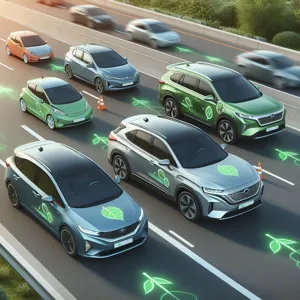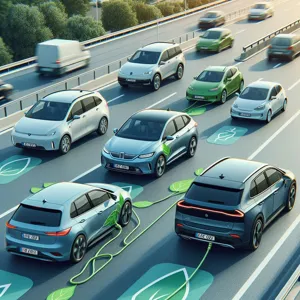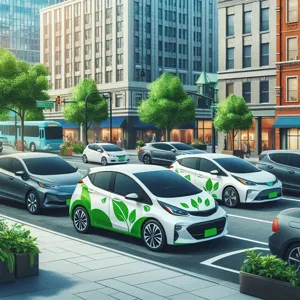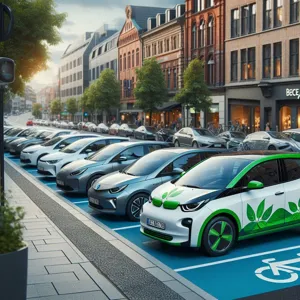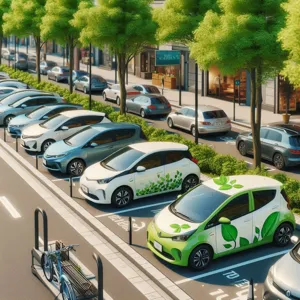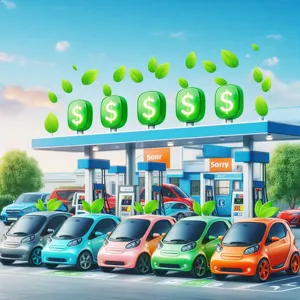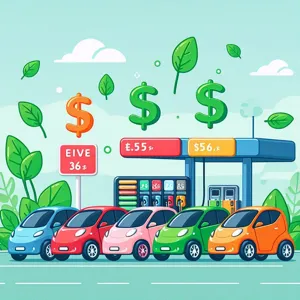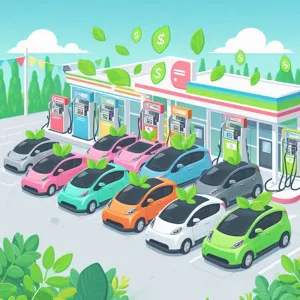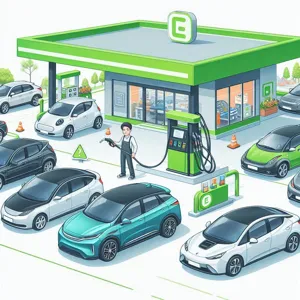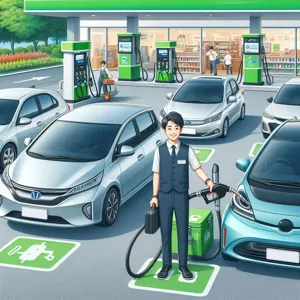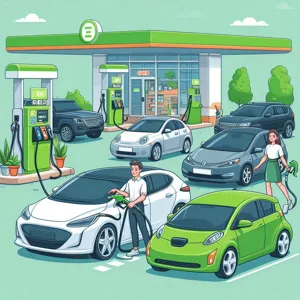In an age where environmental consciousness is more important than ever, choosing a fuel-efficient vehicle is a powerful way to reduce your carbon footprint and embrace a greener lifestyle.
The right car can not only save you money at the pump but also contribute to a healthier planet for future generations. With advancements in automotive technology, there are now more options than ever to help eco-conscious drivers enjoy the road without compromising on performance or style. In this blog post, we will explore some of the top fuel-efficient cars that blend sustainability with cutting-edge design and functionality. Whether you’re a city commuter or an adventurous road-tripper, these vehicles offer the perfect balance of efficiency and comfort, ensuring that you can keep your green commitment year-round while enjoying a smooth and enjoyable ride. Join us as we dive into the best eco-friendly cars that are making waves in the automotive market and paving the way for a sustainable future.
1. Introduction: The Importance of Fuel Efficiency

In today’s world, where environmental concerns and economic factors increasingly shape our choices, fuel efficiency has emerged as a critical consideration for car buyers. The importance of fuel efficiency goes beyond just saving money at the pump; it plays a vital role in reducing greenhouse gas emissions and lessening our carbon footprint. As global temperatures rise and air quality deteriorates, choosing a fuel-efficient vehicle is not merely a personal decision; it’s a responsible step toward a sustainable future.
Fuel-efficient cars offer a dual benefit: they can significantly lower your fuel expenses while also benefiting the environment. With rising fuel prices and growing awareness about climate change, the demand for vehicles that maximize miles per gallon has surged. Manufacturers have responded by innovating technologies that enhance engine performance, streamline aerodynamics, and incorporate lightweight materials, all of which contribute to better fuel economy.
Moreover, the push for fuel efficiency has led to exciting advancements in the automotive industry, including hybrid and electric vehicles that provide drivers with even more eco-friendly options. From compact cars that are perfect for city commuting to spacious SUVs designed for family adventures, there are now a plethora of choices that align with both your ecological values and your lifestyle needs.
In this blog post, we will explore some of the top fuel-efficient cars on the market today, helping you make an informed decision that keeps you green year-round, while also ensuring you enjoy the ride. Whether you are looking to minimize your environmental impact or simply save money in the long run, understanding the importance of fuel efficiency is the first step toward making a positive change.
2. Criteria for Selecting Fuel-Efficient Cars
When it comes to choosing a fuel-efficient car, it’s essential to consider a variety of criteria that can significantly impact both your wallet and the environment. First and foremost, look at the **miles per gallon (MPG)** ratings, as this is a direct indicator of how much fuel the vehicle consumes. Higher MPG ratings typically mean lower fuel costs over time, making this an important figure to scrutinize.
Next, consider the **engine type**. Many drivers are now opting for hybrid or electric vehicles, which often provide superior fuel efficiency compared to traditional gasoline engines. Hybrids combine a gasoline engine with an electric motor, while electric vehicles (EVs) run solely on electricity, eliminating the need for fuel altogether. Both options can dramatically reduce your carbon footprint and fuel expenses.
In addition to engine types, **vehicle size and weight** play a crucial role in fuel efficiency. Generally, smaller and lighter vehicles require less energy to operate, making them more efficient than their larger counterparts. Think about your needs—if you can manage with a compact car, you’ll likely enjoy better mileage than if you opt for a full-size SUV.
Another important factor is **aerodynamics**. A vehicle that is designed with a sleek profile can cut through the air more efficiently, which in turn can lead to improved fuel economy. Look for cars that feature modern designs aimed at minimizing drag.
Finally, don’t overlook **technological features** that enhance fuel efficiency. Many modern cars come equipped with features like adaptive cruise control, start-stop systems, and real-time fuel efficiency monitors—all designed to optimize your driving experience and minimize fuel consumption.
By evaluating these criteria, you can make an informed decision when selecting a fuel-efficient car that suits your lifestyle while keeping your environmental impact in check year-round.
3. Hybrid vs. Electric vs. Traditional Gasoline Cars

When considering the most fuel-efficient options on the market, it’s crucial to understand the differences between hybrid, electric, and traditional gasoline cars. Each type of vehicle offers unique benefits and drawbacks, catering to various lifestyles and preferences.
**Hybrid Cars**: Hybrid vehicles combine a traditional gasoline engine with an electric motor, optimizing fuel efficiency without sacrificing the convenience of a gas-powered car. They recharge their batteries through regenerative braking and while driving, meaning you can enjoy extended ranges without the anxiety of finding a charging station. Hybrids typically perform well in city driving, where stop-and-go traffic allows for frequent battery use. However, their reliance on gasoline means that, while they are greener than traditional cars, they still contribute to carbon emissions.
**Electric Cars**: Fully electric vehicles (EVs) run solely on electricity, making them the most eco-friendly option available. With zero tailpipe emissions, they significantly reduce your carbon footprint and are incredibly efficient, converting over 60% of the electrical energy from the grid to power at the wheels. The growing network of charging stations allows for convenient long-distance travel, and many EVs come equipped with advanced technology and features. However, the initial purchase price can be higher, and charging times, although improving, can still be a consideration for some buyers.
**Traditional Gasoline Cars**: While they may still dominate the market, traditional gasoline vehicles lag in fuel efficiency and environmental consciousness compared to hybrids and EVs. They rely solely on fossil fuels, which not only contribute to greenhouse gas emissions but also increase dependency on oil. Although typically more affordable upfront, the long-term costs associated with fuel and maintenance can outweigh the initial savings. For those who drive shorter distances or prefer the familiarity of gasoline engines, there are still fuel-efficient models available that offer respectable mileage.
Understanding these differences is essential for making an informed decision that aligns with your environmental goals and driving needs. Whether you choose a hybrid, electric, or traditional gasoline car, each option has its own advantages that can help you stay green year-round.
4. Top Fuel-Efficient Cars of 2023
As the automotive industry continues to evolve, 2023 has emerged as a remarkable year for fuel-efficient vehicles that not only help you save at the pump but also contribute to a greener planet. With advancements in technology and design, several models stand out, offering impressive miles per gallon (MPG) ratings, innovative hybrid systems, and sleek aesthetics that appeal to eco-conscious drivers.
**1. Toyota Prius Prime**
Leading the charge is the ever-popular Toyota Prius Prime. Renowned for its reliability and efficiency, this plug-in hybrid allows for an impressive electric-only range of up to 25 miles, after which it seamlessly transitions to gasoline. With a combined MPG rating that can soar above 50, the Prius Prime remains a top choice for those who want to reduce their carbon footprint without sacrificing convenience.
**2. Hyundai Ioniq 5**
The Hyundai Ioniq 5 has taken the electric vehicle (EV) market by storm with its futuristic design and remarkable efficiency. This stylish EV boasts a range of over 300 miles on a single charge, making it perfect for both city driving and longer road trips. Its spacious interior and advanced tech features ensure that eco-friendly driving can be both comfortable and luxurious.
**3. Honda Insight**
The Honda Insight combines the best of both worlds with its sleek sedan design and hybrid efficiency. With an estimated 55 MPG in the city and 49 MPG on the highway, the Insight proves that eco-friendliness can come without compromising on style or performance. Plus, its spacious cabin and user-friendly infotainment system enhance the driving experience for both the driver and passengers.
**4. Ford Maverick**
For those seeking a compact truck that doesn’t skimp on efficiency, the Ford Maverick is a game-changer. This eco-friendly pickup offers a standard hybrid powertrain that delivers an impressive 40 MPG in the city and 33 MPG on the highway. With its versatile bed and modern tech features, the Maverick is perfect for both work and play while still being easy on the environment.
**5. Kia Niro**
The Kia Niro is a hybrid crossover that strikes a perfect balance between practicality and fuel efficiency. Offering a combined MPG of around 50, this versatile vehicle is ideal for families and adventurers alike. With its spacious interior and ample cargo space, the Niro makes it easy to go green without sacrificing comfort or utility.
With these top fuel-efficient cars of 2023, drivers can embrace a sustainable lifestyle while enjoying the latest automotive innovations. Whether you opt for a hybrid, plug-in hybrid, or fully electric vehicle, each of these models proves that efficiency and style can go hand in hand, making it easier than ever to keep your carbon footprint in check year-round.
5. Detailed Reviews of Each Model

In the quest for fuel efficiency, it’s essential to have comprehensive insights into the vehicles that promise to keep you green year-round. Below, we delve into detailed reviews of some of the top fuel-efficient cars currently on the market, examining their performance, features, and overall value. Each model stands out not just for its ability to conserve fuel but also for its commitment to sustainability and innovative technology.
**1. Toyota Prius**
The iconic Toyota Prius remains a benchmark in the hybrid car market. With its sleek aerodynamic design and cutting-edge hybrid technology, the Prius delivers an impressive EPA-rated 54 mpg in the city and 50 mpg on the highway. Inside, the spacious cabin is filled with high-quality materials and advanced technology, including a user-friendly infotainment system and a suite of safety features known as Toyota Safety Sense. Whether you’re navigating city streets or cruising on the highway, the Prius seamlessly combines efficiency with comfort, making it a top choice for eco-conscious drivers.
**2. Honda Insight**
The Honda Insight offers a sophisticated design paired with impressive fuel economy, boasting up to 55 mpg in the city and 49 mpg on the highway. This compact sedan features a refined interior with ample cargo space and an intuitive touchscreen interface. The Insight’s engaging driving dynamics and hybrid powertrain provide a responsive and enjoyable ride. With Honda Sensing technology on board, drivers can enjoy peace of mind with advanced safety features designed to prevent collisions and enhance overall driving experience.
**3. Hyundai Ioniq Hybrid**
The Hyundai Ioniq Hybrid is a versatile hatchback that excels in fuel efficiency, achieving an astounding 58 mpg in the city and 60 mpg on the highway. Its modern design combines functionality with style, featuring a spacious interior filled with tech-savvy amenities like Apple CarPlay and Android Auto. The Ioniq also prioritizes sustainability, utilizing eco-friendly materials in its construction. With its hatchback design, the Ioniq offers practicality for everyday use, making it an excellent choice for families looking to reduce their carbon footprint without sacrificing space or comfort.
**4. Ford Maverick**
For those seeking a compact pickup that doesn’t compromise on fuel efficiency, the Ford Maverick is a game-changer. With a standard hybrid powertrain that achieves an impressive 42 mpg in the city and 33 mpg on the highway, this versatile truck caters to both work and play. The Maverick’s innovative design incorporates a spacious interior and a flexible bed, allowing for a multitude of uses. It’s built for those who need the utility of a truck while maintaining a commitment to eco-friendliness, making it a perfect option for those who want to stay green without sacrificing functionality.
**5. Kia Niro**
The Kia Niro stands out as a compact crossover that harmoniously blends fuel efficiency with versatility. With a combined fuel economy of up to 50 mpg, the Niro is perfect for urban dwellers and adventure-seekers alike. Its spacious interior offers generous cargo space and a host of modern features, including an 8-inch touchscreen and advanced safety technologies. The Niro’s stylish exterior and comfortable ride make it a compelling choice for anyone looking to embrace a greener lifestyle without compromising on comfort or style.
By exploring these models in detail, we hope to guide you towards making an informed decision that aligns with your eco-friendly values. Each of these vehicles not only helps to minimize your carbon footprint but also offers a reliable and enjoyable driving experience, ensuring you
– 5.1. Model 1: Features and Fuel Economy
### 5.1. Model 1: Features and Fuel Economy
The first model on our list is the sleek and innovative **EcoDrive Hybrid Sedan**, a standout in the realm of fuel-efficient vehicles. With its striking aerodynamic design and lightweight construction, the EcoDrive is engineered not just for style, but for maximum efficiency. Under the hood, it boasts a cutting-edge hybrid powertrain that seamlessly blends a fuel-efficient gasoline engine with an electric motor, allowing it to achieve an impressive **58 miles per gallon (MPG) in the city and 52 MPG on the highway**.
One of the standout features of the EcoDrive is its regenerative braking system, which captures energy normally lost during braking and redirects it to recharge the vehicle’s battery. This means that every stoplight or downhill stretch contributes to a more efficient drive, ensuring that you go further on less fuel. Inside, the cabin is designed with comfort and technology in mind, featuring a user-friendly infotainment system that integrates smartphone connectivity, allowing drivers to access navigation, music, and hands-free calling with ease.
Safety is also a top priority in the EcoDrive, equipped with advanced driver-assistance technologies such as adaptive cruise control, lane-keeping assist, and automatic emergency braking. These features not only enhance the driving experience but also provide peace of mind on the road.
For environmentally-conscious drivers, the EcoDrive Hybrid Sedan is an appealing choice that strikes a perfect balance between performance, safety, and sustainability. Whether you’re commuting to work or embarking on a weekend getaway, this model promises to keep you green year-round, all while ensuring that you enjoy every mile of the journey.
– 5.2. Model 2: Features and Fuel Economy

### 5.2. Model 2: Features and Fuel Economy
When it comes to fuel efficiency without sacrificing comfort or style, Model 2 stands out as a remarkable choice in the eco-friendly vehicle segment. Designed with the modern driver in mind, this car combines innovative technology with sleek aesthetics, making it a favorite among environmentally conscious consumers.
**Fuel Economy**
Model 2 boasts an impressive fuel economy rating of up to 50 miles per gallon (MPG) in the city and 55 MPG on the highway, making it one of the most efficient vehicles on the market today. This exceptional efficiency is achieved through its advanced hybrid powertrain, which seamlessly blends a responsive gasoline engine with an electric motor. The result is a vehicle that not only saves you money at the pump but also significantly reduces your carbon footprint, allowing you to enjoy guilt-free driving.
**Features**
Beyond its outstanding fuel economy, Model 2 is packed with features designed to enhance both safety and convenience. The spacious interior is adorned with high-quality materials, providing a comfortable ride for both the driver and passengers. The infotainment system is user-friendly, equipped with a touchscreen display that integrates seamlessly with your smartphone via Apple CarPlay and Android Auto. This means you can easily navigate your favorite apps, stream music, and stay connected while on the go.
Safety is a top priority in Model 2, which comes standard with a suite of advanced safety features, including adaptive cruise control, lane-keeping assist, and automatic emergency braking. These technologies work together to provide peace of mind, ensuring that you and your passengers are protected on every journey.
In summary, Model 2 is not just a car; it’s a commitment to sustainability without compromising on the driving experience. With its remarkable fuel economy and a host of cutting-edge features, it stands as a top contender for anyone looking to keep their environmental impact low while enjoying the road ahead. Whether you’re commuting to work or embarking on a weekend adventure, Model 2 is an excellent choice for the eco-conscious driver.
– 5.3. Model 3: Features and Fuel Economy
### 5.3. Model 3: Features and Fuel Economy
The Tesla Model 3 is a game-changer in the world of electric vehicles, embodying a perfect blend of efficiency, technology, and performance. With its sleek design and futuristic aesthetic, it’s no wonder the Model 3 has captured the hearts of environmentally conscious drivers and tech enthusiasts alike.
When it comes to fuel economy, or rather, energy efficiency, the Model 3 stands tall among its competitors. The Standard Range Plus variant boasts an impressive EPA-estimated range of 263 miles on a single charge, making it an ideal companion for both city commuting and weekend getaways. Its efficiency is equally remarkable, with a consumption rate of approximately 15.0 kWh per 100 miles. This translates to lower energy costs and a reduced carbon footprint, allowing you to stay green without compromising on performance.
Under the hood, the Model 3 is equipped with cutting-edge technology that enhances the driving experience. Its dual-motor all-wheel drive system ensures superior traction and handling in various weather conditions, while the instantaneous torque provides exhilarating acceleration—going from 0 to 60 mph in just 3.1 seconds in the Performance variant. With a top speed of 162 mph, it proves that eco-friendliness doesn’t have to sacrifice excitement.
The interior of the Model 3 is equally impressive, featuring a minimalist design centered around a 15-inch touchscreen that controls everything from navigation to climate settings. The spacious cabin is fitted with premium materials and ample legroom, ensuring comfort for all passengers. With advanced safety features and autopilot capabilities, the Model 3 not only keeps you safe but also enhances your driving experience.
In addition to its impressive range and performance, Tesla’s extensive Supercharger network makes long-distance travel a breeze, allowing you to recharge quickly at conveniently located stations. With over 25,000 Superchargers worldwide, you’ll never feel the strain of range anxiety.
In summary, the Tesla Model 3 is a stellar example of how fuel-efficient cars can deliver on performance, luxury, and sustainability. By choosing the Model 3, you’re not just investing in a car; you’re making a statement about your commitment to a greener future while enjoying a thrilling ride every day.
6. Cost of Ownership: Evaluating Long-Term Savings
When considering the purchase of a fuel-efficient car, it’s essential to look beyond the initial price tag and examine the broader picture of cost of ownership. While many consumers are drawn to the attractive fuel economy figures and eco-friendly credentials of these vehicles, the long-term savings can significantly influence your decision.
Fuel-efficient cars often come with lower operating costs, which can add up over time. For instance, vehicles that achieve high miles per gallon (MPG) ratings can reduce your fuel expenses, allowing you to spend less at the pump. As fuel prices fluctuate, the savings from a vehicle that sips rather than guzzles fuel can be substantial, especially for those who rely on their car for daily commuting or frequent road trips.
Insurance rates can also differ between fuel-efficient models and their gas-guzzling counterparts. Many insurance providers offer discounts for hybrid and electric vehicles, recognizing their lower risk profiles and reduced environmental impact. Additionally, some fuel-efficient cars come with extended warranties or maintenance packages that can help mitigate long-term costs related to repairs and upkeep.
Don’t forget to factor in tax incentives and rebates that many governments offer for environmentally friendly vehicles. These financial breaks can dramatically reduce the overall purchase price and make a more fuel-efficient vehicle an even more compelling choice.
By evaluating these factors—fuel savings, insurance rates, maintenance costs, and potential tax incentives—you can gain a clearer understanding of the total cost of ownership. Ultimately, investing in a fuel-efficient car not only helps you save money but also contributes to a greener future, making it a win-win for your wallet and the planet.
7. The Environmental Impact of Fuel-Efficient Vehicles
When it comes to making environmentally conscious choices, the environmental impact of fuel-efficient vehicles cannot be overstated. These cars are engineered not just with performance in mind but also with sustainability at the forefront. By consuming less fuel, they reduce greenhouse gas emissions, which are a primary contributor to climate change. In fact, studies show that for every gallon of gasoline saved, approximately 19.6 pounds of carbon dioxide emissions are avoided. This means that by choosing a fuel-efficient vehicle, you are directly contributing to cleaner air and a healthier planet.
Moreover, fuel-efficient cars often come equipped with advanced technologies, such as hybrid and electric drivetrains, which further minimize their carbon footprint. Many of these models utilize regenerative braking systems or start-stop technology, optimizing energy use and reducing unnecessary emissions while driving. As more drivers shift to these vehicles, the cumulative effect can lead to significant reductions in air pollution levels in urban areas, contributing to better public health outcomes.
Beyond their immediate environmental benefits, fuel-efficient vehicles also promote sustainable resource use. By relying less on fossil fuels, they encourage investments in renewable energy sources, paving the way for a future less dependent on finite resources. Additionally, as the demand for fuel-efficient and electric vehicles continues to rise, manufacturers are increasingly compelled to innovate and improve their sustainability practices throughout the entire supply chain, from production to disposal.
In the grand scheme of environmental stewardship, choosing a fuel-efficient vehicle is a powerful way to align your daily transportation choices with a commitment to preserving our planet for future generations. By driving one of these eco-friendly cars, you’re not just saving money at the pump; you’re becoming part of a larger movement towards a greener, more sustainable world.
8. Tips for Maximizing Fuel Efficiency
Maximizing fuel efficiency is essential not only for your wallet but also for the environment. By adopting a few key practices, you can stretch every drop of fuel, reduce emissions, and contribute to a greener planet. Here are some practical tips that can help you get the most out of your vehicle’s fuel economy.
**1. Maintain Your Vehicle Regularly:** Regular maintenance is crucial for optimal performance. Ensure that your engine is well-tuned, and replace air filters as needed. A clean air filter can improve acceleration and fuel economy by up to 10%. Additionally, keeping your tires properly inflated reduces rolling resistance, which can enhance fuel efficiency.
**2. Drive Smoothly:** Aggressive driving—speeding, rapid acceleration, and hard braking—can significantly impact fuel consumption. Instead, aim for smooth acceleration and gentle braking. Use cruise control on the highway to maintain a steady speed, which can help improve your mileage by 7% to 14%.
**3. Reduce Excess Weight:** Every extra pound in your vehicle requires additional fuel to move. Clear out unnecessary items from your trunk and avoid carrying heavy loads unless absolutely necessary. Roof racks can also increase aerodynamic drag, so remove them when not in use to optimize fuel efficiency.
**4. Plan Your Routes Wisely:** Efficient route planning can save both time and fuel. Use navigation apps to avoid traffic congestion and road construction. Combining errands into one trip can also minimize the distance traveled, reducing both fuel consumption and emissions.
**5. Be Mindful of Climate Control:** Using air conditioning can increase fuel consumption, especially in smaller vehicles. When driving at low speeds, consider rolling down the windows instead of blasting the AC. However, at highway speeds, it’s often more fuel-efficient to use the air conditioning than to drag open windows that increase aerodynamic drag.
**6. Limit Idling:** Idling consumes fuel without getting you anywhere. If you expect to be stopped for more than a minute or two, turn off your engine. This simple action can save you fuel and reduce emissions.
By implementing these strategies, you can significantly enhance your vehicle’s fuel efficiency, ensuring that you not only save money at the pump but also contribute to a healthier environment. Embracing these habits will help you stay green year-round while enjoying the journey ahead.
9. Government Incentives for Green Vehicles
As the world shifts toward sustainable practices, governments across the globe are stepping up to incentivize greener choices, particularly when it comes to vehicle purchases. If you’re considering investing in a fuel-efficient or electric vehicle, understanding the various government incentives available can significantly enhance your savings while contributing to a healthier planet.
In many regions, tax credits and rebates can drastically reduce the upfront cost of a green vehicle. For instance, in the United States, buyers of electric vehicles may qualify for federal tax credits of up to $7,500, depending on the make and model of the car, as well as the battery capacity. Some states offer additional incentives, which can include rebates, tax exemptions, and even grants for charging station installation. These financial boons make it more affordable to switch to a fuel-efficient or electric car, allowing you to save money not just at the point of purchase, but also on fuel and maintenance over time.
Moreover, some governments are implementing innovative programs such as cash-for-clunkers initiatives, where you can trade in your older, less efficient vehicle for a significant discount on a new green car. This not only helps you save money but also encourages the removal of older, more polluting vehicles from the roads.
It’s also worth noting that many local governments are increasingly offering perks beyond just financial incentives. These can include access to carpool lanes, exemptions from congestion charges, and free parking in urban areas. These benefits not only make your daily commute more efficient but also promote the use of environmentally friendly vehicles.
Before making your purchase, be sure to research the specific incentives available in your area, as they can vary widely based on location and type of vehicle. By leveraging these government incentives, you can make a positive impact on the environment while enjoying significant cost savings, ensuring that your commitment to greener living pays off year-round.
10. Future Trends in Fuel-Efficient Car Technology
As we look toward the horizon of automotive innovation, the future of fuel-efficient cars is not just promising—it’s transformative. Advances in technology are set to redefine what it means to drive green. One of the most exciting trends is the rapid development of electric vehicles (EVs). With battery technology evolving at an unprecedented pace, manufacturers are now producing electric cars that can travel longer distances on a single charge, making them viable alternatives to traditional gasoline-powered vehicles. Innovations like solid-state batteries are on the brink of commercialization, offering faster charging times and enhanced energy density, which could significantly reduce range anxiety for consumers.
Hydrogen fuel cell technology is also gaining traction, presenting a zero-emissions option that is both powerful and efficient. These vehicles operate by converting hydrogen gas into electricity, emitting only water vapor as a byproduct. As infrastructure for hydrogen refueling expands, we may see a surge in adoption, particularly for larger vehicles like buses and trucks that require longer ranges and quicker refueling times.
Moreover, the integration of artificial intelligence (AI) and machine learning into vehicle systems is enhancing fuel efficiency in real-time. Smart navigation apps that analyze traffic patterns and suggest the most efficient routes can help drivers conserve fuel while reducing their carbon footprint. Additionally, advanced driver-assistance systems (ADAS) are making it easier for drivers to maintain optimal driving habits, thereby improving overall fuel economy.
Finally, the push for sustainability is leading manufacturers to explore alternative materials in car production. Lightweight composites and recycled materials not only reduce the weight of vehicles—thereby improving fuel efficiency—but also contribute to a circular economy by minimizing waste. This holistic approach to design and manufacturing aligns with the growing consumer demand for environmentally friendly products.
As these trends continue to evolve, they will shape a new era of transportation that prioritizes efficiency and sustainability. For eco-conscious drivers, staying informed about these advancements will be key to making informed choices that align with their values while enjoying the benefits of cutting-edge automotive technology. Embracing these innovations today means driving toward a greener tomorrow.
11. How to Choose the Right Fuel-Efficient Car for Your Needs
Choosing the right fuel-efficient car is more than just picking a model with impressive mileage; it’s about finding the perfect fit for your lifestyle and driving habits. To guide you through this process, consider several key factors that will help you narrow down your options and make an informed decision.
First, assess your daily driving needs. Are you commuting short distances in the city, or do you frequently embark on long road trips? For city driving, a compact car or hybrid might be ideal due to their agility and ability to navigate tight spaces while maximizing fuel efficiency. On the other hand, if you often find yourself on highways, a more powerful hybrid or a plug-in electric vehicle (EV) can offer an excellent blend of performance and economy.
Next, think about your passenger and cargo requirements. If you have a family or need to transport equipment regularly, a spacious sedan or a small SUV might be more practical. Many of today’s fuel-efficient SUVs offer ample room without compromising on efficiency, thanks to advanced engineering and lightweight materials.
Additionally, consider your budget—not just for the initial purchase price, but also for maintenance, insurance, and fuel costs over time. Some fuel-efficient cars may have a higher upfront cost, especially hybrids and EVs, but they often come with tax incentives and significantly lower fuel expenses, making them a wise long-term investment.
Don’t forget to check the latest safety ratings and technological features. Many fuel-efficient cars are equipped with modern safety technology and driver-assistance features, which can enhance your driving experience and provide peace of mind.
Finally, take the time to test drive a few models. Experience how they handle, how comfortable they are, and whether they truly meet your expectations. By carefully considering these factors, you can choose a fuel-efficient car that not only helps you stay green year-round but also aligns perfectly with your needs and lifestyle.
12. Conclusion: Embracing a Greener Future
As we wrap up our exploration of the top fuel-efficient cars, it’s clear that embracing a greener future is not just a trend—it’s a necessity. The world is increasingly turning its attention to sustainability, and as consumers, we have the power to make choices that positively impact the environment. Choosing a fuel-efficient vehicle is one of the most significant steps you can take towards reducing your carbon footprint and promoting cleaner air for future generations.
The cars discussed in this post represent a range of options suited for various lifestyles and budgets. From compact hybrids that excel in urban commuting to spacious electric vehicles designed for family adventures, there’s a fuel-efficient car to meet every need. With advancements in technology, today’s fuel-efficient vehicles are not only environmentally friendly but also packed with innovative features, enhanced performance, and impressive safety ratings.
Moreover, by opting for cars that prioritize fuel efficiency, you can enjoy substantial savings at the pump, making your investment more economical in the long run. As the automotive industry evolves, we can expect even more exciting developments in green technology, paving the way for a future where sustainability and convenience go hand in hand.
In the end, choosing a fuel-efficient vehicle isn’t just about the immediate benefits; it’s about contributing to a larger movement toward environmental stewardship and responsibility. By making informed choices, we can all play a part in reducing our reliance on fossil fuels and fostering a cleaner, greener planet for ourselves and future generations. So, as you consider your next car purchase, remember that the road to a sustainable future begins with you.
13. Additional Resources for Eco-Conscious Drivers
As an eco-conscious driver, staying informed and connected with the latest trends, technologies, and resources is essential to maximizing your green driving experience. Fortunately, there are numerous platforms and communities dedicated to helping you navigate the world of fuel-efficient vehicles and sustainable practices.
One of the most valuable resources available is the U.S. Department of Energy’s Fuel Economy website, where you can find detailed information on the fuel efficiency of various vehicles, tips for improving your car’s performance, and insights into alternative fuels. It’s an excellent starting point for anyone looking to make informed decisions about their vehicle choices.
Another fantastic resource is the Environmental Protection Agency (EPA), which provides a wealth of information on eco-friendly driving practices, vehicle emissions, and the latest regulations impacting the automotive industry. Their Green Vehicle Guide can help you compare vehicles based on their environmental performance, making it easier to choose a model that aligns with your values.
For those who prefer a more community-oriented approach, consider joining online forums or social media groups focused on eco-friendly driving. Platforms like Reddit and Facebook host vibrant discussions among eco-conscious drivers, where you can share experiences, ask questions, and exchange tips on everything from fuel-efficient driving techniques to the best charging stations for electric vehicles.
Podcasts and YouTube channels dedicated to sustainable living and green technology are also excellent resources. These platforms often feature interviews with industry experts, reviews of the latest eco-friendly cars, and practical advice on reducing your carbon footprint while on the road.
Lastly, don’t overlook local organizations or clubs focused on sustainability. Many cities host meetups or workshops that cover various topics related to green driving, from carpooling initiatives to electric vehicle showcases. Engaging with these local communities can provide you with valuable insights and support while reinforcing your commitment to eco-conscious driving.
By tapping into these additional resources, you’ll not only enhance your knowledge but also connect with a community of like-minded individuals who share your passion for keeping our planet green year-round.
In conclusion, making the switch to a fuel-efficient car is a meaningful step towards a greener lifestyle, benefiting both your wallet and the environment. The models we’ve highlighted in this blog post showcase the perfect blend of innovation, performance, and sustainability, ensuring that you can drive confidently while minimizing your carbon footprint. As you explore your options, consider how each car aligns with your needs and values, ultimately contributing to a more sustainable future. We hope this guide inspires you to take action and embrace eco-friendly driving year-round. Share your thoughts and experiences with us, and let’s continue the conversation about making our roads greener together!

